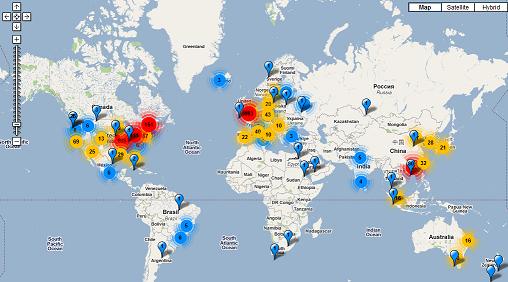
When it comes to genomics, China seems a little like the proverbial kid in the candy store – she wants a taste of everything. Of course, unlike the child, China might be making a bid to own the candy store outright as well. The Beijing Genomics Institute (BGI), now located in Shenzhen, is the leading genomics facility in China, and all of Asia. BGI has striven to make a name for itself in every major international genome sequencing project of the last decade. The International Human Genome Project, the International Human HapMap Project, sequencing SARS, the Sino-British Chicken Genome Project, etc. It was also responsible for completely sequencing the rice genome, the silkworm genome, the giant panda genome…the list goes on an on. By the end of this year BGI will have 128 of Illumina’s HiSeq 2000 platforms, 27 of AB’s SOLiD 4 systems, and many other sequencing devices. At full capacity this means they will be capable of the equivalent of 10,000+ human genomes per year. And they are still growing. BGI may not be the largest genomics facility in the world, but it is has phenomenal support from its government, ambition to expand quickly, and a hand in dozens of major sequencing projects. You can’t talk about the future of genetics without talking about China.
In late 1999 the Beijing Genomics Institute started to build China into a world leader of genetic research. In the decade that’s elapsed since, they’ve put their name on some major developments. Here are just a few of the biggest newsmakers:
- First Asian Diploid Genome Project – The first sequenced genome for a person of Asian descent in late 2007. Published in Nature 2008.
- Cloned Pigs – BGI was instrumental in creating handmade clones of pigs in 2008.
- Giant Panda Genome Project – BGI sequenced the Giant Panda (whose genome is roughly equal to a humans) on its own in just eight months in 2008-2009! Published in Nature 2009.
- Cucumber, and Rice Genome – Among the first sequences of complex plants used as food crops. Cucumber published in Nature 2009.
- Silkworm and Ant Genomes – Among the first sequences of a domesticated insect, and ecologically important insects. Ants published in Science 2010.
- SARS – Sequenced the SARS virus just hours after a Canadian team completed the first mapping of the pathogen.
- Ancient Human – BGI was the first to sequence an ancient human genome (a paleo-Eskimo). Published in Nature in 2010.
Since its inception, BGI has had a very ambitious attitude when it came to participating in world genomics. Every time they were presented with a new project, they basically said, sure, we’ll be a part of that. They contributed 1% to the Human Genome Project’s reference genome, and 10% to the Human HapMap Project. It was like they never met a sequencing project they didn’t like.
That attitude hasn’t seemed to wane at all. BGI is spearheading efforts that will sequence a wide variety of organisms. There’s the 1000Genomes Project aimed at producing a wide database of human genomes from people all over the world. They are also working to sequence 1000 plants and animals, and have already completed 14+ of the former and around 50 of the latter. In 2009, BGI launched its effort to map the genomes of 10,000 microbes – they’ve managed 800 bacteria, 100 fungi, and 100 viruses so far, with more finished every day. They are looking for collaborators to sequence 1000 Mendelian Disorders in humans. Completion of large genetic databases like these will be part of what could empower genetic research to finally make the discoveries the public has been waiting for since the first human genome was sequenced a decade ago.
Even while BGI is a testament to Chinese ambitions in genomics, it also speaks to the prominence of the US in that field. BGI relies heavily, almost exclusively, on sequencing technology rooted in California. Illumina’s HiSeq2000 and Applied Biosystems SOLiD 4 form the bulk of BGI’s machine workforce. To be fair, most of the world has focused on using these systems as well, and BGI is working to expand its hardware horizons, collaborating with OpGen on new optical sequencing methods. Still, when one sees BGI’s successes in genomics one also has to acknowledge that such capabilities weren’t developed in a vacuum. China’s sequencing projects, like every nation’s sequencing projects, have worked as part of a larger global effort.
The only real question, then, is how much will China simply be a part of that worldwide phenomenon, and how much will it lead? Even if the hardware is largely developed by California companies, those companies themselves are international entities. BGI is officially part of the sequencing club, recognized by Illumina as one of its associated world class facilities. BGI isn’t some second tier group working its way to the top, it’s already at the top, sharing space with the other lead genomics institutions around the world. If BGI and China continue to dedicate money, labor, and insight into genomics, they’ll be able to set the agenda for many sequencing projects around the globe. Actually, they’re already doing this with their various sequencing projects for microorganisms, plants, animals, and humans.
I know that many of us will view BGI’s growing importance through the lens of competitive national spirit. Yet no matter your feelings about China, you have to view BGI’s accomplishments as wonderful gifts to the global scientific community. Every genomics center around the world is going to have different specialties (Complete Genomics is dedicated to bringing down the costs of human whole genome sequencing, for instance) and it’s only through combining these disparate efforts that we’ll create the general understanding we need to move the field of genetics forward. It’s a team effort. Yay China, Yay us.

[image credits: BGI, Pathogenomics]
[sources: BGI]


